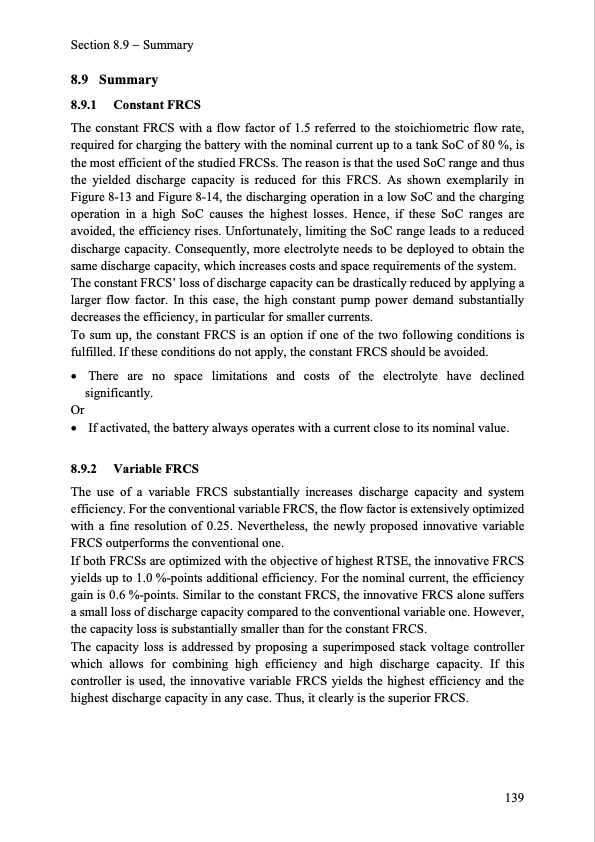
PDF Publication Title:
Text from PDF Page: 147
Section 8.9 Summary 8.9 Summary 8.9.1 Constant FRCS The constant FRCS with a flow factor of 1.5 referred to the stoichiometric flow rate, required for charging the battery with the nominal current up to a tank SoC of 80 %, is the most efficient of the studied FRCSs. The reason is that the used SoC range and thus the yielded discharge capacity is reduced for this FRCS. As shown exemplarily in Figure 8-13 and Figure 8-14, the discharging operation in a low SoC and the charging operation in a high SoC causes the highest losses. Hence, if these SoC ranges are avoided, the efficiency rises. Unfortunately, limiting the SoC range leads to a reduced discharge capacity. Consequently, more electrolyte needs to be deployed to obtain the same discharge capacity, which increases costs and space requirements of the system. The constant FRCS’ loss of discharge capacity can be drastically reduced by applying a larger flow factor. In this case, the high constant pump power demand substantially decreases the efficiency, in particular for smaller currents. To sum up, the constant FRCS is an option if one of the two following conditions is fulfilled. If these conditions do not apply, the constant FRCS should be avoided. There are no space limitations and costs of the electrolyte have declined significantly. Or If activated, the battery always operates with a current close to its nominal value. 8.9.2 Variable FRCS The use of a variable FRCS substantially increases discharge capacity and system efficiency. For the conventional variable FRCS, the flow factor is extensively optimized with a fine resolution of 0.25. Nevertheless, the newly proposed innovative variable FRCS outperforms the conventional one. If both FRCSs are optimized with the objective of highest RTSE, the innovative FRCS yields up to 1.0 %-points additional efficiency. For the nominal current, the efficiency gain is 0.6 %-points. Similar to the constant FRCS, the innovative FRCS alone suffers a small loss of discharge capacity compared to the conventional variable one. However, the capacity loss is substantially smaller than for the constant FRCS. The capacity loss is addressed by proposing a superimposed stack voltage controller which allows for combining high efficiency and high discharge capacity. If this controller is used, the innovative variable FRCS yields the highest efficiency and the highest discharge capacity in any case. Thus, it clearly is the superior FRCS. 139PDF Image | Model-based Design Vanadium Redox Flow Batteries

PDF Search Title:
Model-based Design Vanadium Redox Flow BatteriesOriginal File Name Searched:
10-5445IR1000070670.pdfDIY PDF Search: Google It | Yahoo | Bing
Salgenx Redox Flow Battery Technology: Salt water flow battery technology with low cost and great energy density that can be used for power storage and thermal storage. Let us de-risk your production using our license. Our aqueous flow battery is less cost than Tesla Megapack and available faster. Redox flow battery. No membrane needed like with Vanadium, or Bromine. Salgenx flow battery
| CONTACT TEL: 608-238-6001 Email: greg@salgenx.com | RSS | AMP |